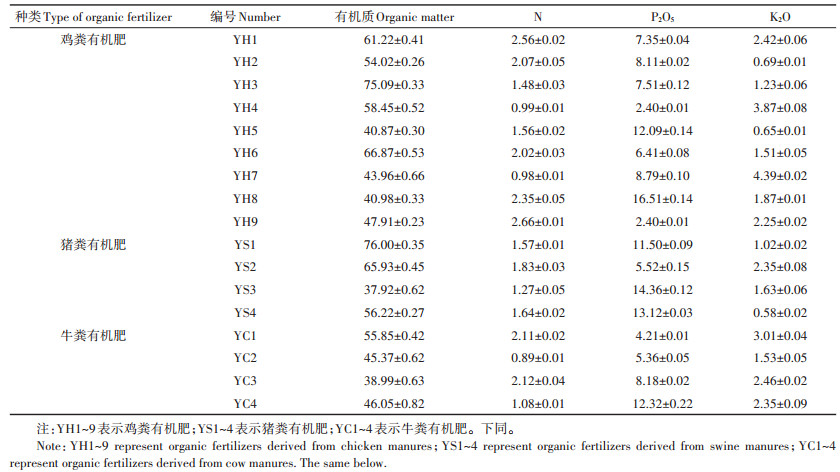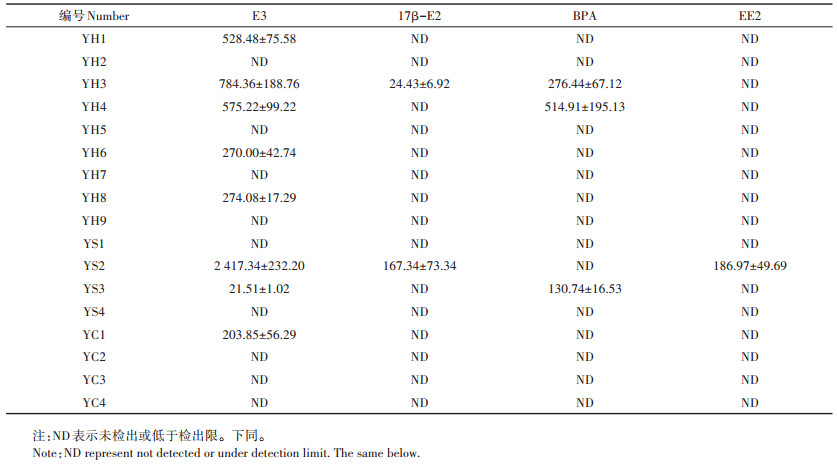2. 苏州建邦环境修复有限责任公司, 江苏 苏州 215000
2. Suzhou Built State Environmental Restoration Co., Ltd., Suzhou 215000, China
有机肥又称农家肥,具有成分复杂、肥效长、养分全面等特点。农业生产中施用有机肥,可增加土壤肥力、提高作物产量和改善品质,其施用效果得到普遍肯定[1-3]。随着人们对食品安全意识的提高,生态农业和绿色食品愈来愈受到重视,使得有机肥料的应用也越加广泛[4]。有机肥料原料来源丰富,如人畜粪便、堆沤肥、污泥、绿肥、杂肥及各种垃圾等[5]。近年来集约化禽畜养殖业快速发展,禽畜粪便成为有机肥主要来源[6]。
雌激素是由动物体内细胞所分泌出来的一种化学物质,能够协调生物体各种生理过程[7]。但排入环境中的雌激素会通过模拟、干扰机体内生激素原有的正常合成、运输和释放,使其无法维持自身的平衡和调节,可引起人类和动物的雌性化[8-9]。作为雌激素重要来源之一的养殖业畜禽粪便,会携带大量的雌激素[10-11]。通过施肥进入农业土壤,对环境、动物及植物等造成不良的影响,并最终会随食物链影响人类健康[12]。有机肥料中雌激素污染状况及其施用的生态安全研究已刻不容缓。
鉴于畜禽粪便有机肥对土壤及生态环境存在的潜在危害,国内外已针对其中的重金属和抗生素污染展开大量研究[13-15],并对有机肥中各种污染物制定了一系列安全标准[16-18]。但关于有机肥中雌激素污染鲜有报道,并且已有标准中没有具体指标涉及雌激素的残留问题。有关有机肥中雌激素的污染特征数据极度缺乏,市面上经生物发酵的有机肥中雌激素污染状况尚不明确。本文收集了17个畜禽粪便商品有机肥样品,检测了有机肥中雌激素的种类和含量,分析畜禽粪便制成的有机肥中雌激素的污染特征,为阐释有机肥中雌激素对环境的危害提供重要理论依据。
1 材料与方法 1.1 雌激素标准品及商品有机肥雌三醇(E3,98%)、17β-雌二醇(17β-E2,98%)、双酚A(BPA,99%)标准品均购自上海晶纯试剂有限公司,炔雌醇(EE2,99%)标准品购自美国Sigma公司。甲醇(色谱纯)、乙酸乙酯(分析纯)和乙腈(色谱纯)购自南京化学试剂股份有限公司。共收集商品有机肥样品17个,其中9个鸡粪有机肥样品、4个猪粪有机肥样品和4个牛粪有机肥样品。
1.2 有机肥基本性状分析方法采用《有机肥料》(NY 525—2012)对有机肥样品中有机质、氮、磷和钾等的测定方法进行检测。
1.3 有机肥中雌激素检测方法采用SPE-HPLC/FLD法[19-20]检测有机肥中雌激素含量。称取冷冻干燥并经粉碎机粉碎后过20目筛的(1.00±0.01)g有机肥样品,加入1.00 mL的雌激素(空白组加入等量的甲醇)混合标准溶液(1 mg·L-1),混合均匀后放置12 h,再加入20 mL提取剂(乙酸乙酯),涡旋30 s后超声提取1 h,并以4000 r·min-1离心30 min,取5 mL上清液通过C18固相萃取柱,用15.00 mL体积比为1:1的甲醇和乙酸乙酯混合液洗脱,洗脱液收集至小试管中。将小试管置于40 ℃的恒温水浴并用氮气缓慢吹干,然后加入甲醇溶液涡旋混合,将附着物重新溶解至2.00 mL,过0.22 μm孔径滤膜后,HPLC/FLD分析。色谱条件:色谱柱为Inertsil ODS-SP-C18(150 mm×4.6 mm,5 μm);流动相为甲醇/乙腈/水(体积比为20:30:50);流速1.00 mL·min-1;柱温40 ℃;进样量20 μL;荧光检测器采用波长切换,切换方式如下,0~5.2 min激发/发射波长为300/450 nm,5.2~7.1 min激发/发射波长为280/310 nm,6.1~ 10.4 min激发/发射波长为300/450 nm,10.4 min~25.0 min激发/发射波长为280/310 nm。
2 结果与讨论 2.1 有机肥的基本性状不同畜禽粪便有机肥中主要营养物质含量如表 1所示。鸡粪有机肥、猪粪有机肥和牛粪有机肥中有机质均值分别为54.17%、59.02%和46.57%;N均值分别为1.85%、1.58%和1.55%;P2O5均值分别为7.96%、11.13%和7.52%;K2O均值分别为2.10%、1.39%和2.34%。从表 1可知,所收集的17种有机肥样品绝大部分都满足《有机肥料》(NY 525—2012)中对有机肥的营养物质含量的要求:有机质≥45%,总养分(N+P2O5 + K2O)≥5.0%。但有机肥样品中的鸡粪样品YH5、YH7、YH8,猪粪样品YS3以及牛粪样品YC3中有机质含量低于标准,未能达到有机肥质量要求,需要加强质量监管力度。
|
|
表 1 畜禽粪便有机肥中主要营养物质含量(%) Table 1 Main nutrients content in organic fertilizers from livestock manures(%) |
各种脊椎动物雌激素的排放种类和排放量因动物种类、生长阶段、年龄和性别差异而不同[21-22],本文选择了普遍存在的天然雌激素E3、17β-E2以及合成雌激素BPA、EE2进行研究。采用SPE-HPLC/FLD法对有机肥样品中E3、17β-E2、BPA和EE2进行检测,结果如表 2所示。有机肥样品YH2、YH5、YH7、YH9、YS1、YS4、YC2、YC3、YC4未检测到雌激素,其余8个有机肥样品均有不同含量的雌激素被检出。有机肥中雌激素含量范围和均值如表 3所示,E3、17β-E2、BPA和EE2的含量(干质量计)范围分别为ND~2 417.34、ND~167.34、ND~514.91 μg·kg-1和ND~186.97 μg·kg-1。E3、17β-E2、BPA和EE2的均值(干质量计)分别为298.52、11.28、54.24 μg·kg-1和11.00 μg·kg-1。说明市场上畜禽粪便有机肥中部分产品含有雌激素,并且含量较高,这种产品施加到农田土壤将造成一系列安全隐患。所以,在售卖、使用畜禽粪便有机肥前,应对雌激素进行检测,并制定安全标准。而四种雌激素中E3的含量远高于17β-E2、BPA和EE2三种雌激素,表明有机肥中E3相对于其余三种雌激素存在较大的污染风险。因此对于畜禽有机肥需重视E3的潜在污染风险,同时不能忽视17β-E2、BPA和EE2的污染风险。
|
|
表 2 有机肥中雌激素含量(μg·kg-1) Table 2 The concentration of estrogens in organic fertilizers(μg·kg-1) |
|
|
表 3 有机肥中雌激素含量和均值(μg·kg-1) Table 3 The concentration of estrogens in organic fertilizers(μg·kg-1) |
将鸡粪、猪粪、牛粪有机肥中雌激素与此前研究[11]中新鲜鸡粪、猪粪、牛粪中雌激素(表 4)进行比较。此前研究所用新鲜鸡粪、猪粪、牛粪样品采自南京附近各处养殖场,而本研究收集有机肥并不是由这些新鲜粪便制备。所以,有机肥中E3(298.52 µg· kg-1)、17β-E2(11.28 µg·kg-1)、BPA(54.24 µg·kg-1)、EE2(11.00 µg·kg-1)含量并未表现出明显比新鲜粪便中E3(218.95 µg·kg-1)、17β-E2(42.83 µg·kg-1)、BPA(43.44 µg·kg-1)、EE2(19.84 µg·kg-1)含量低的现象,而检出率相对于含量更具有对比意义。有机肥和新鲜粪便中雌激素检出率如图 1所示,鸡粪、猪粪、牛粪有机肥中四种雌激素的检出率均明显低于对应新鲜粪便。所有有机肥中E3、17β-E2、BPA、EE2检出率分别为47.06%、11.76%、17.65%、5.88%,而新鲜粪便中E3、17β-E2、BPA、EE2检出率则分别高达67.74%、70.97%、70.97%、58.06%,说明将新鲜粪便通过堆肥发酵制备有机肥能够使雌激素发生降解而含量降低[12, 23]。但有机肥中雌激素检出率仍然较高,所以目前所用堆肥发酵制备有机肥工艺仍需改进。此外,牛粪新鲜粪便中雌激素含量和检出率相对鸡粪、猪粪较低,制备的有机肥中雌激素较易降解完全,所以牛粪有机肥中雌激素含量和检测率非常低。牛粪有机肥相对鸡粪、猪粪有机肥污染风险更小,更能满足环境保护的需要。
|
|
表 4 新鲜鸡粪、猪粪、牛粪中雌激素的含量[11]( μg·kg-1) Table 4 The concentration of estrogens in chicken, swine and cow fresh manures[11] (μg·kg-1) |

|
图 1 有机肥和新鲜粪便中雌激素检出率 Figure 1 Detection rate of estrogens in organic fertilizers and fresh manures |
(1)对采集的有机肥样品中有机质、全氮、全磷、全钾进行检测,发现并不是所有产品都能达到《有机肥料》(NY 525—2012)中对有机肥营养物质含量的要求。
(2)对采集的有机肥样品中雌激素进行检测,发现市场上畜禽粪便有机肥中部分产品含有雌激素,且含量较高,其中E3的含量远高于17β-E2、BPA和EE2,存在较大的污染风险。
(3)将有机肥中雌激素与新鲜畜禽粪便中雌激素进行对比,发现有机肥中四种雌激素检出率均明显较低,说明将新鲜粪便通过堆肥发酵制成有机肥能够使雌激素发生降解,从而降低污染风险,但有机肥中雌激素检出率仍然较高。此外,三种粪便制备的有机肥中,牛粪有机肥中雌激素含量和检出率更低,较为安全。
| [1] |
Bolan N S, Adriano D C, Natesan R, et al. Effects of organic amendments on the reduction and phytoavailability of chromate in mineral soil[J]. Journal of Environmental Quality, 2003, 32(1): 120-128. DOI:10.2134/jeq2003.1200 |
| [2] |
Witter E, Martensson A M, Garcia F V. Size of the soil microbial biomass in a long-term field experiment as affected by different N-fertilizers and organic manures[J]. Soil Biology & Biochemistry, 1993, 25(6): 659-669. |
| [3] |
杨文叶, 季淑枫, 李丹, 等. 连续施用商品有机肥对耕地质量及蔬菜产量的影响[J]. 农业资源与环境学报, 2014, 31(4): 319-322. YANG Wen-ye, JI Shu-feng, LI Dan, et al. Effect of continuous application of commercial organic manure on farmland quality and vegetable yield[J]. Journal of Agricultural Resources and Environment, 2014, 31(4): 319-322. |
| [4] |
刘荣乐, 李书田, 王秀斌, 等. 我国商品有机肥料和有机废弃物中重金属的含量状况与分析[J]. 农业环境科学学报, 2005, 24(2): 392-397. LIU Rong-le, LI Shu-tian, WANG Xiu-bin, et al. Contents of heavy metal in commercial organic fertilizers and organic wastes[J]. Journal of Agro-Environment Science, 2005, 24(2): 392-397. DOI:10.3321/j.issn:1672-2043.2005.02.041 |
| [5] |
姚丽贤, 周修冲. 有机肥对环境的影响及预防研究[J]. 中国生态农业学报, 2005, 13(2): 113-115. YAO Li-xian, ZHOU Xiu-chong. Impact of organic manure on the environment and its corresponding preventive researches[J]. Chinese Journal of Eco-Agriculture, 2005, 13(2): 113-115. |
| [6] |
张树清, 张夫道, 刘秀梅, 等. 规模化养殖畜禽粪主要有害成分测定分析研究[J]. 植物营养与肥料学报, 2005, 11(6): 822-829. ZHANG Shu-qing, ZHANG Fu-dao, LIU Xiu-mei, et al. Determination and analysis on main harmful composition in excrement of scale livestock and poultry feedlots[J]. Plant Nutrition and Fertilizer Science, 2005, 11(6): 822-829. DOI:10.3321/j.issn:1008-505X.2005.06.019 |
| [7] |
Mayes M D. Epidemiologic studies of environmental agents and systemic autoimmune diseases[J]. Environmental Health Perspectives, 1999, 107(Suppl 5): 743-748. DOI:10.1289/ehp.99107s5743 |
| [8] |
Tapiero H, Ba G N, Tew K D. Estrogens and environmental estrogens[J]. Biomedicine & Pharmacotherapy, 2002, 56(1): 36-44. |
| [9] |
刘静娴, 刘娟, 孙敏霞, 等. 抗生素对雌二醇降解菌JX-2降解性能的影响[J]. 农业环境科学学报, 2016, 35(8): 1488-1497. LIU Jing-xian, LIU Juan, SUN Min-xia, et al. Effects of antibiotics on the estradiol degradation by strain JX-2[J]. Journal of Agro-Environment Science, 2016, 35(8): 1488-1497. |
| [10] |
刘敏, 岳波, 尹平河, 等. 畜禽粪便改良土壤中E1和E2自然降解的影响因素[J]. 环境科学研究, 2011, 24(10): 1166-1171. LIU Min, YUE Bo, YIN Ping-he, et al. Factors influencing the natural degradation of E1(Estrone)and E2(17β-Estradiol)in soils amended by animal manure[J]. Research of Environmental Sciences, 2011, 24(10): 1166-1171. |
| [11] |
Xu P C, Zhou X, Xu D F, et al. Contamination and risk assessment of estrogens in livestock manure:A case study in Jiangsu Province, China[J]. International Journal of Environmental Research and Public Health, 2018, 15(1): E125. DOI:10.3390/ijerph15010125 |
| [12] |
Zhang H, Shi J S, Liu X W, et al. Occurrence of free estrogens, conjugated estrogens, and bisphenol a in fresh livestock excreta and their removal by composting in north China[J]. Environmental Science and Pollution Research, 2014, 21(16): 9939-9947. DOI:10.1007/s11356-014-3002-9 |
| [13] |
史奕, 赵牧秋, 王俊, 等. 设施菜地土壤-植物系统中有机肥源抗生素的影响研究进展[J]. 农业环境科学学报, 2010, 29(Suppl 1): 240-244. SHI Yi, ZHAO Mu-qiu, WANG Jun, et al. Effect of antibiotics from organic manure on protected vegetable soil-plant system:A review[J]. Journal of Agro-Environment Science, 2010, 29(Suppl 1): 240-244. |
| [14] |
Wang F, Zhao L X, Shen Y J, et al. Analysis of heavy metal contents and source tracing in organic fertilizer from livestock manure in north China[J]. Transactions of the CSAE, 2013, 29(19): 202-208. |
| [15] |
刘赫, 李双异, 汪景宽. 长期施用有机肥对棕壤中主要重金属积累的影响[J]. 生态环境学报, 2009, 18(6): 2177-2182. LIU He, LI Shuang-yi, WANG Jing-kuan. Effects of long-term application of organic manure on accumulation of main heavy metals in brown earth[J]. Ecology and Environmental Sciences, 2009, 18(6): 2177-2182. DOI:10.3969/j.issn.1674-5906.2009.06.033 |
| [16] |
唐春玲.畜禽粪便类有机肥中主要环境污染物的分析检测及对蔬菜生长、品质的影响研究[D].上海: 华东理工大学, 2011. TANG Chun-ling. Analysis and detection of the main environmental pollutants content in compost produced by animal manure and their effects on the growth and quality of vegetable[D]. Shanghai: East China University of Science and Technology, 2011. http://cdmd.cnki.com.cn/Article/CDMD-10251-1011050711.htm |
| [17] |
Huang J F, Ni X W, Xie J P, et al. Formulation of organic fertilizer standard in Jiaxing City based on NY 525-2012[J]. Asian Agricultural Research, 2013, 5(4): 124-125. |
| [18] |
茹淑华, 苏德纯, 张永志, 等. 河北省集约化养殖场畜禽粪便中重金属含量及变化特征[J]. 农业资源与环境学报, 2016, 33(6): 533-539. RU Shu-hua, SU De-chun, ZHANG Yong-zhi, et al. Contents and characteristics of heavy metals in the livestock and poultry manure from the large-scale farms in Hebei Province, China[J]. Journal of Agricultural Resources and Environment, 2016, 33(6): 533-539. |
| [19] |
付银杰, 凌婉婷, 董长勋, 等. 应用UE-SPE-HPLC/FLD法检测养殖业畜禽粪便中雌激素[J]. 应用生态学报, 2013, 24(11): 3280-3288. FU Yin-jie, LING Wan-ting, DONG Chang-xun, et al. Estrogens determination of livestock dung based on UE-SPE-HPLC/FLD[J]. Chinese Journal of Applied Ecology, 2013, 24(11): 3280-3288. |
| [20] |
李欣, 凌婉婷, 刘静娴, 等. 固定化菌剂对污水和牛粪中雌二醇和己烯雌酚的去除作用[J]. 环境科学, 2015, 36(7): 2581-2590. LI Xin, LING Wan-ting, LIU Jing-xian, et al. Immobilization of estrogen-degrading bacteria to remove the 17β-estradiol and diethylstilbestrol from polluted water and cow dung[J]. Environmental Science, 2015, 36(7): 2581-2590. |
| [21] |
Hansen P D, Dizer H, Hock B, et al. Vitellogenin:A biomarker for endocrine disruptors[J]. TRAC Trends in Analytical Chemistry, 1998, 17(7): 448-451. DOI:10.1016/S0165-9936(98)00020-X |
| [22] |
李艳霞, 韩伟, 林春野, 等. 畜禽养殖过程中雌激素的排放及其环境行为[J]. 生态学报, 2010, 30(4): 1058-1065. LI Yan-xia, HAN Wei, LIN Chun-ye, et al. Excretion of estrogens in the livestock and poultry production and their environmental behaviors[J]. Acta Ecologica Sinica, 2010, 30(4): 1058-1065. |
| [23] |
Liu J, Li S Y, Li X, et al. Removal of estrone, 17β-estradiol, and estriol from sewage and cow dung by immobilized Novosphingobium sp. ARI-1[J]. Environmental Technology, 2018, 39(19): 2423-2433. DOI:10.1080/09593330.2017.1355935 |
 2019, Vol. 36
2019, Vol. 36






